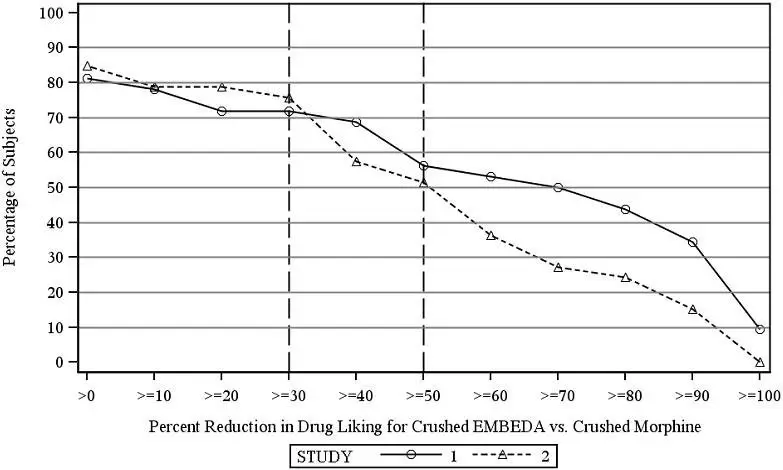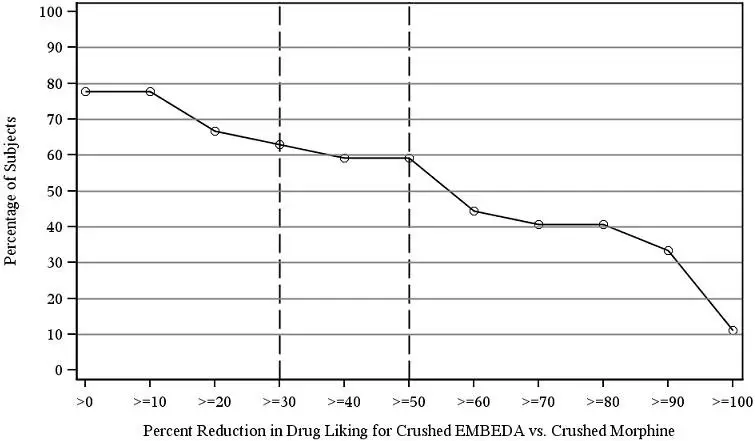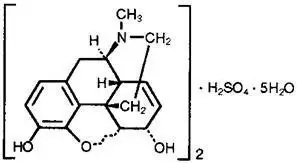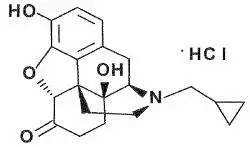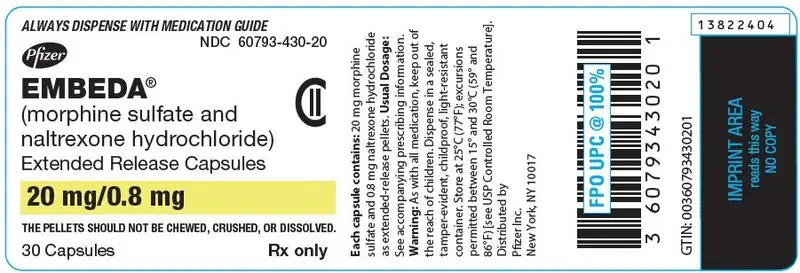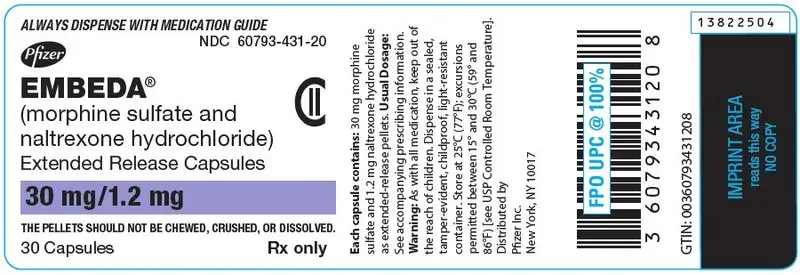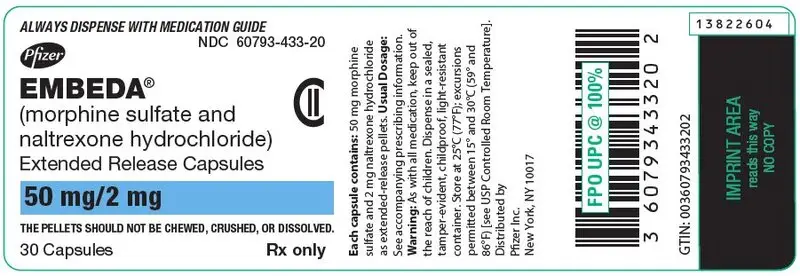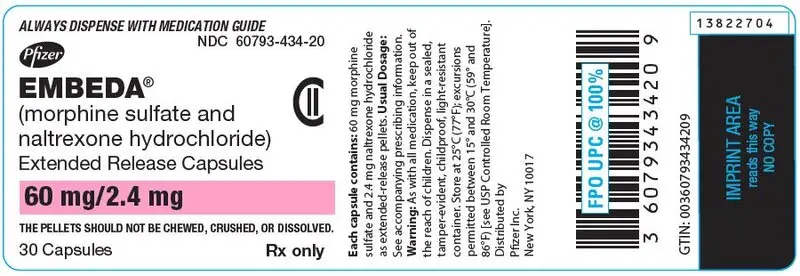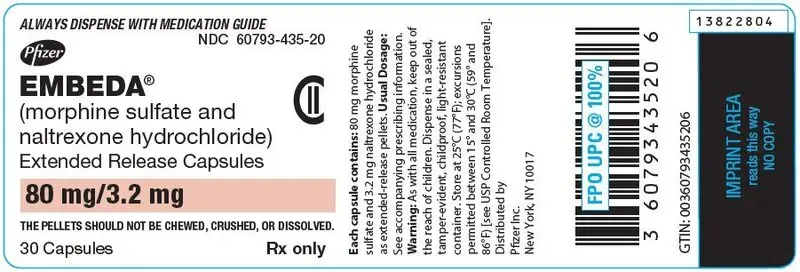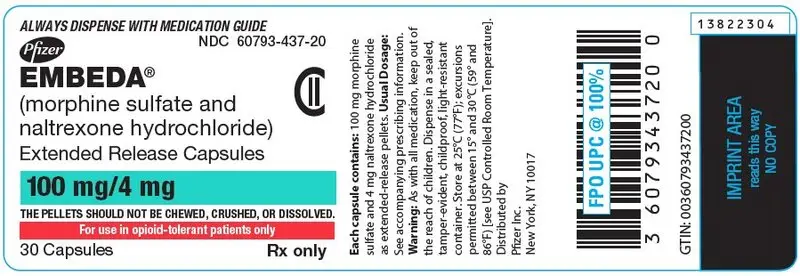Drug Detail:Embeda (Morphine and naltrexone [ mor-feen-and-nal-trex-one ])
Drug Class: Narcotic analgesic combinations
Highlights of Prescribing Information
EMBEDA® (morphine sulfate and naltrexone hydrochloride)
extended-release capsules, for oral use, CII
Initial U.S. Approval: 2009
WARNING: ADDICTION, ABUSE, AND MISUSE; RISK EVALUATION AND MITIGATION STRATEGY (REMS); LIFE-THREATENING RESPIRATORY DEPRESSION; ACCIDENTAL INGESTION; NEONATAL OPIOID WITHDRAWAL SYNDROME; INTERACTION WITH ALCOHOL; and RISKS FROM CONCOMITANT USE WITH BENZODIAZEPINES OR OTHER CNS DEPRESSANTS
See full prescribing information for complete boxed warning.
- EMBEDA exposes users to risks of addiction, abuse, and misuse, which can lead to overdose and death. Assess each patient's risk before prescribing, and monitor regularly for these behaviors and conditions. (5.1)
- To ensure that the benefits of opioid analgesics outweigh the risks of addiction, abuse, and misuse, the Food and Drug Administration (FDA) has required a Risk Evaluation and Mitigation Strategy (REMS) for these products. (5.2)
- Serious, life-threatening, or fatal respiratory depression may occur. Monitor closely, especially upon initiation or following a dose increase. Instruct patients to swallow EMBEDA capsules whole to avoid exposure to a potentially fatal dose of morphine. (5.3)
- Accidental ingestion of EMBEDA, especially by children, can result in fatal overdose of morphine. (5.3)
- Prolonged use of EMBEDA during pregnancy can result in neonatal opioid withdrawal syndrome, which may be life-threatening if not recognized and treated. If prolonged opioid use is required in a pregnant woman, advise the patient of the risk of neonatal opioid withdrawal syndrome and ensure that appropriate treatment will be available (5.4).
- Instruct patients not to consume alcohol or any products containing alcohol while taking EMBEDA because co-ingestion can result in fatal plasma morphine levels. (5.5)
- Concomitant use of opioids with benzodiazepines or other central nervous system (CNS) depressants, including alcohol, may result in profound sedation, respiratory depression, coma, and death. Reserve concomitant prescribing for use in patients for whom alternative treatment options are inadequate; limit dosages and durations to the minimum required; and follow patients for signs and symptoms of respiratory depression and sedation. (5.5, 7)
Recent Major Changes
| Dosage and Administration (2.5) | 10/2019 |
| Warnings and Precautions (5.3, 5.13) | 10/2019 |
Indications and Usage for Embeda
EMBEDA is a combination opioid agonist/opioid antagonist product indicated for the management of pain severe enough to require daily, around-the-clock, long-term opioid treatment and for which alternative treatment options are inadequate. (1)
Limitations of Use
- Because of the risks of addiction, abuse, and misuse with opioids, even at recommended doses, and because of the greater risks of overdose and death with extended-release opioid formulations, reserve EMBEDA for use in patients for whom alternative treatment options (e.g., non-opioid analgesics or immediate-release opioids) are ineffective, not tolerated, or would be otherwise inadequate to provide sufficient management of pain.(1)
- EMBEDA is not indicated as an as-needed (prn) analgesic. (1)
Embeda Dosage and Administration
- To be prescribed only by healthcare providers knowledgeable in use of potent opioids for management of chronic pain. (2.1)
- EMBEDA 100 mg/4 mg capsules, a single dose greater than 60 mg/2.4 mg, or a total daily dose greater than 120 mg/5 mg are only for patients in whom tolerance to an opioid of comparable potency is established. (2.1)
- Patients considered opioid-tolerant are those taking, for one week or longer, at least 60 mg of morphine per day, 25 mcg transdermal fentanyl per hour, 30 mg of oral oxycodone per day, 8 mg of oral hydromorphone per day, 25 mg oral oxymorphone per day, 60 mg oral hydrocodone per day, or an equianalgesic dose of another opioid. (2.1)
- Use the lowest effective dosage for the shortest duration consistent with individual patient treatment goals. (2.1)
- Individualize dosing based on the severity of pain, patient response, prior analgesic experience, and risk factors for addiction, abuse, and misuse. (2.1)
- Instruct patients to swallow EMBEDA capsules intact, or to sprinkle the capsule contents on applesauce and immediately swallow without chewing. (2.1)
- Instruct patients not to cut, break, crush, dissolve, or chew the pellets in the capsule to avoid the risk of release and absorption of a potentially fatal dose of morphine, and to avoid release of sequestered naltrexone that could precipitate opioid withdrawal. (2.1, 5.1)
- For opioid-naïve and opioid non-tolerant patients, initiate with 20 mg/0.8 mg capsules (morphine sulfate/naltrexone hydrochloride) orally every 24 hours. (2.2)
- Do not abruptly discontinue EMBEDA in a physically dependent patient because rapid discontinuation of opioid analgesics has resulted in serious withdrawal symptoms, uncontrolled pain, and suicide. (2.5, 5.13)
Dosage Forms and Strengths
Extended-release capsules (morphine sulfate/naltrexone hydrochloride): 20 mg/0.8 mg, 30 mg/1.2 mg, 50 mg/2 mg, 60 mg/2.4 mg, 80 mg/3.2 mg, 100 mg/4 mg (3)
Contraindications
- Significant respiratory depression (4)
- Acute or severe bronchial asthma in an unmonitored setting or in the absence of resuscitative equipment (4)
- Concurrent use of monoamine oxidase inhibitors (MAOIs) or use of MAOIs within the last 14 days (5.7)
- Known or suspected gastrointestinal obstruction, including paralytic ileus (4)
- Hypersensitivity to morphine or naltrexone (4)
Warnings and Precautions
- Life-Threatening Respiratory Depression in Patients with Chronic Pulmonary Disease or in Elderly, Cachectic, or Debilitated Patients: Monitor closely, particularly during initiation and titration. (5.6)
- Adrenal Insufficiency: If diagnosed, treat with physiologic replacement of corticosteroids, and wean patient off of the opioid. (5.8)
- Severe Hypotension: Monitor during dosage initiation and titration. Avoid use of EMBEDA in patients with circulatory shock. (5.9)
- Risk of Use in Patients with Increased Intracranial Pressure, Brain Tumors, Head Injury or Impaired Consciousness: Monitor for sedation and respiratory depression. Avoid use of EMBEDA in patients with impaired consciousness or coma. (5.10)
Adverse Reactions/Side Effects
Most common adverse reactions (>10%): constipation, nausea, and somnolence. (6.1)
To report SUSPECTED ADVERSE REACTIONS, contact Pfizer, Inc. at 1-800-438-1985 or FDA at 1-800-FDA-1088 or www.fda.gov/medwatch.
Drug Interactions
- Serotonergic Drugs: Concomitant use may result in serotonin syndrome. Discontinue EMBEDA if serotonin syndrome is suspected. (7)
- Mixed Agonist/Antagonist and Partial Agonist Opioid Analgesics: Avoid use with EMBEDA because they may reduce analgesic effect of EMBEDA or precipitate withdrawal symptoms. (5.13, 7)
Use In Specific Populations
- Pregnancy: May cause fetal harm. (8.1)
- Lactation: Not recommended. (8.3)
See 17 for PATIENT COUNSELING INFORMATION and Medication Guide.
Revised: 10/2019
Full Prescribing Information
WARNING: ADDICTION, ABUSE, AND MISUSE; RISK EVALUATION AND MITIGATION STRATEGY (REMS); LIFE-THREATENING RESPIRATORY DEPRESSION; ACCIDENTAL INGESTION; NEONATAL OPIOID WITHDRAWAL SYNDROME; INTERACTION WITH ALCOHOL; and RISKS FROM CONCOMITANT USE WITH BENZODIAZEPINES OR OTHER CNS DEPRESSANTS
Addiction, Abuse, and Misuse
EMBEDA® exposes patients and other users to the risks of opioid addiction, abuse, and misuse, which can lead to overdose and death. Assess each patient's risk prior to prescribing EMBEDA, and monitor all patients regularly for the development of these behaviors and conditions [see Warnings and Precautions (5.1)].
Opioid Analgesic Risk Evaluation and Mitigation Strategy (REMS)
To ensure that the benefits of opioid analgesics outweigh the risks of addiction, abuse, and misuse, the Food and Drug Administration (FDA) has required a REMS for these products [see Warnings and Precautions (5.2)]. Under the requirements of the REMS, drug companies with approved opioid analgesic products must make REMS-compliant education programs available to healthcare providers. Healthcare providers are strongly encouraged to
- complete a REMS-compliant education program,
- counsel patients and/or their caregivers, with every prescription, on safe use, serious risks, storage, and disposal of these products,
- emphasize to patients and their caregivers the importance of reading the Medication Guide every time it is provided by their pharmacist, and
- consider other tools to improve patient, household, and community safety.
Life-threatening Respiratory Depression
Serious, life-threatening, or fatal respiratory depression may occur with use of EMBEDA. Monitor for respiratory depression, especially during initiation of EMBEDA or following a dose increase. Instruct patients to swallow EMBEDA capsules whole, or to sprinkle the contents of the capsule on applesauce and swallow immediately without chewing. Crushing, chewing, or dissolving the pellets in EMBEDA can cause rapid release and absorption of a potentially fatal dose of morphine [see Warnings and Precautions (5.3)].
Accidental Ingestion
Accidental ingestion of even one dose of EMBEDA, especially by children, can result in a fatal overdose of morphine [see Warnings and Precautions (5.3)].
Neonatal Opioid Withdrawal Syndrome
Prolonged use of EMBEDA during pregnancy can result in neonatal opioid withdrawal syndrome, which may be life-threatening if not recognized and treated, and requires management according to protocols developed by neonatology experts. If opioid use is required for a prolonged period in a pregnant woman, advise the patient of the risk of neonatal opioid withdrawal syndrome and ensure that appropriate treatment will be available [see Warnings and Precautions (5.4)].
Interaction with Alcohol
Instruct patients not to consume alcoholic beverages or use prescription or non-prescription products that contain alcohol while taking EMBEDA. The co-ingestion of alcohol with EMBEDA may result in increased plasma level and a potentially fatal overdose of morphine [see Warnings and Precautions (5.5)].
Risks From Concomitant Use With Benzodiazepines Or Other CNS Depressants
Concomitant use of opioids with benzodiazepines or other central nervous system (CNS) depressants, including alcohol, may result in profound sedation, respiratory depression, coma, and death [see Warnings and Precautions (5.5), Drug Interactions (7)].
- Reserve concomitant prescribing of EMBEDA and benzodiazepines or other CNS depressants for use in patients for whom alternative treatment options are inadequate.
- Limit dosages and durations to the minimum required.
- Follow patients for signs and symptoms of respiratory depression and sedation.
1. Indications and Usage for Embeda
EMBEDA is indicated for the management of pain severe enough to require daily, around-the-clock, long-term opioid treatment and for which alternative treatment options are inadequate.
2. Embeda Dosage and Administration
2.1 Important Dosage and Administration Instructions
EMBEDA should be prescribed only by healthcare professionals who are knowledgeable in the use of potent opioids for the management of chronic pain.
EMBEDA 100 mg/4 mg capsules, a single dose greater than 60 mg/2.4 mg, or a total daily dose greater than 120 mg/5 mg, are only for use in patients in whom tolerance to an opioid of comparable potency is established. Patients considered opioid-tolerant are those receiving, for one week or longer, at least 60 mg oral morphine per day, 25 mcg transdermal fentanyl per hour, 30 mg of oral oxycodone per day, 8 mg of oral hydromorphone per day, 25 mg oral oxymorphone per day, 60 mg oral hydrocodone per day, or an equianalgesic dose of another opioid.
- Use the lowest effective dosage for the shortest duration consistent with individual patient treatment goals [see Warnings and Precautions (5)].
- Initiate the dosing regimen for each patient individually; taking into account the patient's severity of pain, patient response, prior analgesic treatment experience, and risk factors for addiction, abuse, and misuse [see Warnings and Precautions (5.1)].
- Monitor patients closely for respiratory depression, especially within the first 24–72 hours of initiating therapy and following dosage increases with EMBEDA and adjust the dosage accordingly [see Warnings and Precautions (5.3)].
Instruct patients to swallow EMBEDA capsules whole [see Patient Counseling Information (17)]. Crushing, chewing, or dissolving EMBEDA capsules will result in uncontrolled delivery of morphine and can lead to overdose or death [see Warnings and Precautions (5.1)].
Instruct patients who are unable to swallow EMBEDA to sprinkle the capsule contents on applesauce and immediately swallow without chewing [see Dosage and Administration (2.6)].
EMBEDA is administered orally at a frequency of either once daily (every 24 hours) or twice daily (every 12 hours).
2.3 Titration and Maintenance of Therapy
Individually titrate EMBEDA to a dose that provides adequate analgesia and minimizes adverse reactions. Continually reevaluate patients receiving EMBEDA to assess the maintenance of pain control and the relative incidence of adverse reactions, as well as monitoring for the development of addiction, abuse, or misuse [see Warnings and Precautions (5.1)]. Frequent communication is important among the prescriber, other members of the healthcare team, the patient, and the caregiver/family during periods of changing analgesic requirements, including initial titration. During chronic therapy, periodically reassess the continued need for opioid analgesics.
Patients who experience breakthrough pain may require a dosage adjustment of EMBEDA, or may need rescue medication with an appropriate dose of an immediate-release analgesic. If the level of pain increases after dose stabilization, attempt to identify the source of increased pain before increasing the EMBEDA dosage. In patients experiencing inadequate analgesia with once-daily dosing of EMBEDA, consider a twice-daily regimen. Because steady-state plasma concentrations are approximated within 24 to 36 hours, EMBEDA dose may be adjusted every 1 to 2 days.
If unacceptable opioid-related adverse reactions are observed, consider reducing the dosage. Adjust the dosage to obtain an appropriate balance between management of pain and opioid-related adverse reactions.
2.4 Dosage Modifications with Concomitant Use of Central Nervous System Depressants
If the patient is currently taking a central nervous system (CNS) depressant and the decision is made to begin EMBEDA, start with 1/3 to 1/2 the recommended starting dosage of EMBEDA, monitor patients for signs of respiratory depression, sedation, and hypotension, and consider using a lower dosage of the concomitant CNS depressant [see Warnings and Precautions (5.5), Drug Interactions (7)].
2.5 Safe Reduction or Discontinuation of EMBEDA
Do not abruptly discontinue EMBEDA in patients who may be physically dependent on opioids. Rapid discontinuation of opioid analgesics in patients who are physically dependent on opioids has resulted in serious withdrawal symptoms, uncontrolled pain, and suicide. Rapid discontinuation has also been associated with attempts to find other sources of opioid analgesics, which may be confused with drug-seeking for abuse. Patients may also attempt to treat their pain or withdrawal symptoms with illicit opioids, such as heroin, and other substances.
When a decision has been made to decrease the dose or discontinue therapy in an opioid-dependent patient taking, there are a variety of factors that should be considered, including the dose of EMBEDA the patient has been taking, the duration of treatment, the type of pain being treated, and the physical and psychological attributes of the patient. It is important to ensure ongoing care of the patient and to agree on an appropriate tapering schedule and follow-up plan so that patient and provider goals and expectations are clear and realistic. When opioid analgesics are being discontinued due to a suspected substance use disorder, evaluate and treat the patient, or refer for evaluation and treatment of the substance use disorder. Treatment should include evidence-based approaches, such as medication assisted treatment of opioid use disorder. Complex patients with co-morbid pain and substance use disorders may benefit from referral to a specialist.
There are no standard opioid tapering schedules that are suitable for all patients. Good clinical practice dictates a patient-specific plan to taper the dose of the opioid gradually. For patients on EMBEDA who are physically opioid-dependent, initiate the taper by a small enough increment (e.g., no greater than 10% to 25% of the total daily dose) to avoid withdrawal symptoms, and proceed with dose-lowering at an interval of every 2 to 4 weeks. Patients who have been taking opioids for briefer periods of time may tolerate a more rapid taper.
It may be necessary to provide the patient with lower dosage strengths to accomplish a successful taper. Reassess the patient frequently to manage pain and withdrawal symptoms, should they emerge. Common withdrawal symptoms include restlessness, lacrimation, rhinorrhea, yawning, perspiration, chills, myalgia, and mydriasis. Other signs and symptoms also may develop, including irritability, anxiety, backache, joint pain, weakness, abdominal cramps, insomnia, nausea, anorexia, vomiting, diarrhea, or increased blood pressure, respiratory rate, or heart rate. If withdrawal symptoms arise, it may be necessary to pause the taper for a period of time or raise the dose of the opioid analgesic to the previous dose, and then proceed with a slower taper. In addition, monitor patients for any changes in mood, emergence of suicidal thoughts, or use of other substances.
When managing patients taking opioid analgesics, particularly those who have been treated for a long duration and/or with high doses for chronic pain, ensure that a multimodal approach to pain management, including mental health support (if needed), is in place prior to initiating an opioid analgesic taper. A multimodal approach to pain management may optimize the treatment of chronic pain, as well as assist with the successful tapering of the opioid analgesic [see Warnings and Precautions (5.13), Drug Abuse and Dependence (9.3)].
2.6 Administration of EMBEDA
Instruct patients to swallow EMBEDA capsules intact. The capsules contain pellets that consist of morphine and sequestered naltrexone. The pellets in the capsules are not to be crushed, dissolved, or chewed due to the risk of rapid release and absorption of a potentially fatal dose of morphine [see Warnings and Precautions (5.1)]. Consuming EMBEDA capsules that have been altered by crushing, chewing, or dissolving the pellets can release sufficient naltrexone to precipitate withdrawal in opioid-dependent individuals [see Warnings and Precautions (5.13)].
Alternatively, the contents of the EMBEDA capsules (pellets) may be sprinkled over applesauce and then swallowed. This method is appropriate only for patients able to reliably swallow the applesauce without chewing. Other foods have not been tested and should not be substituted for applesauce. Instruct the patient to:
- Sprinkle the pellets onto a small amount of applesauce and consume immediately without chewing.
- Rinse the mouth to ensure all pellets have been swallowed.
- Discard any unused portion of the EMBEDA capsules after the contents have been sprinkled on applesauce.
Do not administer EMBEDA pellets through a nasogastric or gastric tube.
3. Dosage Forms and Strengths
Extended-release capsules (morphine sulfate/naltrexone hydrochloride): 20 mg/0.8 mg, 30 mg/1.2 mg, 50 mg/2 mg, 60 mg/2.4 mg, 80 mg/3.2 mg, 100 mg/4 mg. EMBEDA capsules contain creamy white to light tan spheroidal pellets, have an outer opaque capsule with colors as identified below.
| EMBEDA 20 mg/0.8 mg | EMBEDA 30 mg/1.2 mg | EMBEDA 50 mg/2 mg | EMBEDA 60 mg/2.4 mg | EMBEDA 80 mg/3.2 mg | EMBEDA 100 mg/4 mg |
|
|---|---|---|---|---|---|---|
| Morphine sulfate | 20 mg | 30 mg | 50 mg | 60 mg | 80 mg | 100 mg |
| Sequestered naltrexone hydrochloride | 0.8 mg | 1.2 mg | 2 mg | 2.4 mg | 3.2 mg | 4 mg |
| Extended-Release Capsule Description
For all strengths, the darker-toned cap has "EMBEDA" printed in grey ink and a single grey band around ¾ of the circumference. | Two-toned, yellow opaque hard gelatin capsule. The lighter-toned body has "20" reverse-printed in a grey circle. | Two-toned, blue-violet opaque hard gelatin capsule. The lighter-toned body has "30" reverse-printed in a grey circle. | Two-toned, blue opaque hard gelatin capsule. The lighter-toned body has "50" reverse-printed in a grey circle. | Two-toned, pink opaque hard gelatin capsule. The lighter-toned body has "60" reverse-printed in a grey circle. | Two-toned, light peach opaque elongated hard gelatin capsule. The lighter-toned body has "80" reverse-printed in a grey circle. | Two-toned, green opaque hard gelatin capsule. The lighter-toned body has "100" reverse-printed in a grey circle. |
4. Contraindications
EMBEDA is contraindicated in patients with:
- Significant respiratory depression [see Warnings and Precautions (5.3)]
- Acute or severe bronchial asthma in an unmonitored setting or in the absence of resuscitative equipment [see Warnings and Precautions (5.6)]
- Concurrent use of monoamine oxidase inhibitors (MAOIs) or use of MAOIs within the last 14 days [see Warnings and Precautions (5.7)]
- Known or suspected gastrointestinal obstruction, including paralytic ileus [see Warnings and Precautions (5.11)]
- Hypersensitivity (e.g., anaphylaxis) to morphine or naltrexone [see Adverse Reactions (6.2)]
5. Warnings and Precautions
5.1 Addiction, Abuse, and Misuse
EMBEDA contains morphine, a Schedule II controlled substance. As an opioid, EMBEDA exposes users to the risks of addiction, abuse, and misuse [see Drug Abuse and Dependence (9)]. Because extended-release products such as EMBEDA deliver the opioid over an extended period of time, there is a greater risk for overdose and death due to the larger amount of morphine present [see Drug Abuse and Dependence (9)].
Although the risk of addiction in any individual is unknown, it can occur in patients appropriately prescribed EMBEDA. Addiction can occur at recommended doses and if the drug is misused or abused.
Assess each patient's risk for opioid addiction, abuse, or misuse prior to prescribing EMBEDA, and monitor all patients receiving EMBEDA for the development of these behaviors and conditions. Risks are increased in patients with a personal or family history of substance abuse (including drug or alcohol abuse or addiction) or mental illness (e.g., major depression). The potential for these risks should not, however, prevent the proper management of pain in any given patient. Patients at increased risk may be prescribed opioids such as EMBEDA, but use in such patients necessitates intensive counseling about the risks and proper use of EMBEDA along with intensive monitoring for signs of addiction, abuse, and misuse.
Abuse or misuse of EMBEDA by crushing, chewing, snorting, or injecting the dissolved product will result in the uncontrolled delivery of the morphine and can result in overdose and death [see Overdosage (10)]. Misuse or abuse of EMBEDA by these methods may also release sufficient naltrexone to precipitate withdrawal in opioid-dependent individuals [see Warnings and Precautions (5.13)].
Opioids are sought by drug abusers and people with addiction disorders and are subject to criminal diversion. Consider these risks when prescribing or dispensing EMBEDA. Strategies to reduce these risks include prescribing the drug in the smallest appropriate quantity and advising the patient on the proper disposal of unused drug [see Patient Counseling Information (17)]. Contact local state professional licensing board or state controlled substances authority for information on how to prevent and detect abuse or diversion of this product.
5.2 Opioid Analgesic Risk Evaluation and Mitigation Strategy (REMS)
To ensure that the benefits of opioid analgesics outweigh the risks of addiction, abuse, and misuse, the Food and Drug Administration (FDA) has required a Risk Evaluation and Mitigation Strategy (REMS) for these products. Under the requirements of the REMS, drug companies with approved opioid analgesic products must make REMS-compliant education programs available to healthcare providers. Healthcare providers are strongly encouraged to do all of the following:
- Complete a REMS-compliant education program offered by an accredited provider of continuing education (CE) or another education program that includes all the elements of the FDA Education Blueprint for Health Care Providers Involved in the Management or Support of Patients with Pain.
- Discuss the safe use, serious risks, and proper storage and disposal of opioid analgesics with patients and/or their caregivers every time these medicines are prescribed. The Patient Counseling Guide (PCG) can be obtained at this link: www.fda.gov/OpioidAnalgesicREMSPCG.
- Emphasize to patients and their caregivers the importance of reading the Medication Guide that they will receive from their pharmacist every time an opioid analgesic is dispensed to them.
- Consider using other tools to improve patient, household, and community safety, such as patient-prescriber agreements that reinforce patient-prescriber responsibilities.
To obtain further information on the opioid analgesic REMS and for a list of accredited REMS CME/CE, call 1-800-503-0784, or log on to www.opioidanalgesicrems.com. The FDA Blueprint can be found at www.fda.gov/OpioidAnalgesicREMSBlueprint.
5.3 Life-Threatening Respiratory Depression
Serious, life-threatening, or fatal respiratory depression has been reported with the use of opioids, even when used as recommended. Respiratory depression, if not immediately recognized and treated, may lead to respiratory arrest and death. Management of respiratory depression may include close observation, supportive measures, and use of opioid antagonists, depending on the patient's clinical status [see Overdosage (10)]. Carbon dioxide (CO2) retention from opioid-induced respiratory depression can exacerbate the sedating effects of opioids.
While serious, life-threatening, or fatal respiratory depression can occur at any time during the use of EMBEDA, the risk is greatest during the initiation of therapy or following a dosage increase. Monitor patients closely for respiratory depression especially during the first 24–72 hours of initiating therapy with and following dosage increases of EMBEDA.
To reduce the risk of respiratory depression, proper dosing and titration of EMBEDA are essential [see Dosage and Administration (2)]. Overestimating the EMBEDA dosage when converting patients from another opioid product can result in fatal overdose with the first dose.
Accidental ingestion of even one dose of EMBEDA, especially by children, can result in respiratory depression and death due to an overdose of morphine.
Opioids can cause sleep-related breathing disorders including central sleep apnea (CSA) and sleep-related hypoxemia. Opioid use increases the risk of CSA in a dose-dependent fashion. In patients who present with CSA, consider decreasing the opioid dosage using best practices for opioid taper [see Dosage and Administration (2.5)].
5.4 Neonatal Opioid Withdrawal Syndrome
Prolonged use of EMBEDA during pregnancy can result in withdrawal in the neonate. Neonatal opioid withdrawal syndrome, unlike opioid withdrawal syndrome in adults, may be life-threatening if not recognized and treated, and requires management according to protocols developed by neonatology experts. Observe newborns for signs of neonatal opioid withdrawal syndrome and manage accordingly. Advise pregnant women using opioids for a prolonged period of the risk of neonatal opioid withdrawal syndrome and ensure that appropriate treatment will be available [see Use in Specific Populations (8.1), Patient Counseling Information (17)].
5.5 Risks from Concomitant Use with Benzodiazepines or Other CNS Depressants
Profound sedation, respiratory depression, coma, and death may result from the concomitant use of EMBEDA with benzodiazepines or other CNS depressants (e.g., non-benzodiazepine sedatives/hypnotics, anxiolytics, tranquilizers, muscle relaxants, general anesthetics, antipsychotics, other opioids, alcohol). Because of these risks, reserve concomitant prescribing of these drugs for use in patients for whom alternative treatment options are inadequate.
Observational studies have demonstrated that concomitant use of opioid analgesics and benzodiazepines increases the risk of drug-related mortality compared to use of opioid analgesics alone. Because of similar pharmacological properties, it is reasonable to expect similar risk with the concomitant use of other CNS depressant drugs with opioid analgesics [see Drug Interactions (7)].
If the decision is made to prescribe a benzodiazepine or other CNS depressant concomitantly with an opioid analgesic, prescribe the lowest effective dosages and minimum durations of concomitant use. In patients already receiving an opioid analgesic, prescribe a lower initial dose of the benzodiazepine or other CNS depressant than indicated in the absence of an opioid, and titrate based on clinical response. If an opioid analgesic is initiated in a patient already taking a benzodiazepine or other CNS depressant, prescribe a lower initial dose of the opioid analgesic, and titrate based on clinical response. Follow patients closely for signs and symptoms of respiratory depression and sedation.
Advise both patients and caregivers about the risks of respiratory depression and sedation when EMBEDA is used with benzodiazepines or other CNS depressants (including alcohol and illicit drugs). Advise patients not to drive or operate heavy machinery until the effects of concomitant use of the benzodiazepine or other CNS depressant have been determined. Screen patients for risk of substance use disorders, including opioid abuse and misuse, and warn them of the risk for overdose and death associated with the use of additional CNS depressants including alcohol and illicit drugs [see Drug Interactions (7), Patient Counseling Information (17)].
Patients must not consume alcoholic beverages or prescription or non-prescription products containing alcohol while on EMBEDA therapy. The co-ingestion of alcohol with EMBEDA may result in increased plasma levels and a potentially fatal overdose of morphine [see Clinical Pharmacology (12.3)].
5.6 Life-Threatening Respiratory Depression in Patients with Chronic Pulmonary Disease or in Elderly, Cachectic, or Debilitated Patients
The use of EMBEDA in patients with acute or severe bronchial asthma in an unmonitored setting or in the absence of resuscitative equipment is contraindicated.
5.7 Interaction with Monoamine Oxidase Inhibitors
Monoamine oxidase inhibitors (MAOIs) may potentiate the effects of morphine, including respiratory depression, coma, and confusion. EMBEDA should not be used in patients taking MAOIs or within 14 days of stopping such treatment.
5.8 Adrenal Insufficiency
Cases of adrenal insufficiency have been reported with opioid use, more often following greater than one month of use. Presentation of adrenal insufficiency may include non-specific symptoms and signs including nausea, vomiting, anorexia, fatigue, weakness, dizziness, and low blood pressure. If adrenal insufficiency is suspected, confirm the diagnosis with diagnostic testing as soon as possible. If adrenal insufficiency is diagnosed, treat with physiologic replacement doses of corticosteroids. Wean the patient off of the opioid to allow adrenal function to recover and continue corticosteroid treatment until adrenal function recovers. Other opioids may be tried as some cases reported use of a different opioid without recurrence of adrenal insufficiency. The information available does not identify any particular opioids as being more likely to be associated with adrenal insufficiency.
5.9 Severe Hypotension
EMBEDA may cause severe hypotension including orthostatic hypotension and syncope in ambulatory patients. There is increased risk in patients whose ability to maintain blood pressure has already been compromised by a reduced blood volume or concurrent administration of certain CNS depressant drugs (e.g., phenothiazines or general anesthetics) [see Drug Interactions (7)]. Monitor these patients for signs of hypotension after initiating or titrating the dosage of EMBEDA. In patients with circulatory shock, EMBEDA may cause vasodilation that can further reduce cardiac output and blood pressure. Avoid the use of EMBEDA in patients with circulatory shock.
5.10 Use in Patients with Increased Intracranial Pressure, Brain Tumors, Head Injury, or Impaired Consciousness
In patients susceptible to the intracranial effects of CO2 retention (e.g., those with evidence of increased intracranial pressure or brain tumors), EMBEDA may reduce respiratory drive, and the resultant CO2 retention can further increase intracranial pressure. Monitor such patients for signs of sedation and respiratory depression, particularly when initiating therapy with EMBEDA.
Opioids may also obscure the clinical course in a patient with a head injury. Avoid the use of EMBEDA in patients with impaired consciousness or coma.
5.11 Risks of Use in Patients with Gastrointestinal Conditions
EMBEDA is contraindicated in patients with known or suspected gastrointestinal obstruction, including paralytic ileus. The morphine in EMBEDA may cause spasm of the sphincter of Oddi. Opioids may cause increases in serum amylase. Monitor patients with biliary tract disease, including acute pancreatitis, for worsening symptoms.
5.12 Increased Risk of Seizures in Patients with Seizure Disorders
The morphine in EMBEDA may increase the frequency of seizures in patients with seizure disorders, and may increase the risk of seizures in other clinical settings associated with seizures. Monitor patients with a history of seizure disorders for worsened seizure control during EMBEDA therapy.
5.13 Withdrawal
Do not abruptly discontinue EMBEDA in a patient physically dependent on opioids. When discontinuing EMBEDA in a physically dependent patient, gradually taper the dosage. Rapid tapering of morphine and naltrexone in a patient physically dependent on opioids may lead to a withdrawal syndrome and return of pain [see Dosage and Administration (2.5), Drug Abuse and Dependence (9.3)].
Additionally, avoid the use of mixed agonist/antagonist (e.g., pentazocine, nalbuphine, and butorphanol) or partial agonist (e.g., buprenorphine) analgesics in patients who have received or are receiving a full opioid agonist analgesic, including EMBEDA. In these patients, mixed agonists/antagonist and partial agonist analgesics may reduce the analgesic effect and/or may precipitate withdrawal symptoms.
Consuming EMBEDA capsules that have been altered by crushing, chewing, or dissolving the pellets can release sufficient naltrexone to precipitate withdrawal in opioid-dependent individuals. Symptoms of withdrawal usually appear within five minutes of ingestion of naltrexone, can last for up to 48 hours, and can include mental status changes, restlessness, lacrimation, rhinorrhea, yawning, perspiration, chills, myalgia, and mydriasis. Significant fluid losses from vomiting and diarrhea can require intravenous (IV) fluid administration.
5.14 Risks of Driving and Operating Machinery
EMBEDA may impair the mental or physical abilities needed to perform potentially hazardous activities such as driving a car or operating machinery. Warn patients not to drive or operate dangerous machinery unless they are tolerant to the effects of EMBEDA and know how they will react to the medication [see Patient Counseling Information (17)].
5.15 Interference with Laboratory Tests
Naltrexone does not interfere with thin-layer, gas-liquid, and high performance liquid chromatographic methods which may be used for the separation and detection of morphine, methadone, or quinine in the urine. Naltrexone may or may not interfere with enzymatic methods for the detection of opioids depending on the specificity of the test. Consult the test manufacturer for specific details.
6. Adverse Reactions/Side Effects
The following serious adverse reactions described, or described in greater detail, in other sections:
- Addiction, Abuse, and Misuse [see Warnings and Precautions (5.1)]
- Life-Threatening Respiratory Depression [see Warnings and Precautions (5.3)]
- Neonatal Opioid Withdrawal Syndrome [see Warnings and Precautions (5.4)]
- Interactions with Benzodiazepine or Other CNS Depressants [see Warnings and Precautions (5.5)]
- Interaction with Monoamine Oxidase Inhibitors [see Warnings and Precautions (5.7)]
- Adrenal Insufficiency [see Warnings and Precautions (5.8)]
- Severe Hypotension [see Warnings and Precautions (5.9)]
- Gastrointestinal Adverse Reactions [see Warnings and Precautions (5.11)]
- Seizures [see Warnings and Precautions (5.12)]
- Withdrawal [see Warnings and Precautions (5.13)]
6.1 Clinical Trials Experience
Because clinical trials are conducted under widely varying conditions, adverse reaction rates observed in the clinical trials of a drug cannot be directly compared with rates in the clinical trials of another drug and may not reflect the rates observed in practice.
In the randomized study, the most common adverse reactions with EMBEDA therapy were constipation, nausea, and somnolence. The most common adverse reactions leading to study discontinuation were nausea, constipation (sometimes severe), vomiting, fatigue, dizziness, pruritus, and somnolence.
6.2 Postmarketing Experience
The following adverse reactions have been identified during post-approval use of morphine. Because these reactions are reported voluntarily from a population of uncertain size, it is not always possible to reliably estimate their frequency or establish a causal relationship to drug exposure.
Serotonin syndrome: Cases of serotonin syndrome, a potentially life-threatening condition, have been reported during concomitant use of opioids with serotonergic drugs.
Adrenal insufficiency: Cases of adrenal insufficiency have been reported with opioid use, more often following greater than one month of use.
Anaphylaxis: Anaphylaxis has been reported with ingredients contained in EMBEDA.
Androgen deficiency: Cases of androgen deficiency have occurred with chronic use of opioids [see Clinical Pharmacology (12.2)].
7. Drug Interactions
Table 3 includes clinically significant drug interactions with EMBEDA.
| Alcohol | |
| Clinical Impact: | Concomitant use of alcohol with EMBEDA can result in an increase of morphine plasma levels and potentially fatal overdose of morphine. |
| Intervention: | Instruct patients not to consume alcoholic beverages or use prescription or non-prescription products containing alcohol while on EMBEDA therapy [see Warnings and Precautions (5.5), Clinical Pharmacology (12.3)]. |
| Benzodiazepines and Other Central Nervous System (CNS) Depressants | |
| Clinical Impact: | Due to additive pharmacologic effect, the concomitant use of benzodiazepines or other CNS depressants, including alcohol, can increase the risk of hypotension, respiratory depression, profound sedation, coma, and death. |
| Intervention: | Reserve concomitant prescribing of these drugs for use in patients for whom alternative treatment options are inadequate. Limit dosages and durations to the minimum required. Follow patients closely for signs of respiratory depression and sedation [see Dosage and Administration (2.4) and Warnings and Precautions (5.5)]. |
| Examples: | Benzodiazepines, and other sedatives/hypnotics, anxiolytics, tranquilizers, muscle relaxants, general anesthetics, antipsychotics, other opioids, alcohol. |
| Serotonergic Drugs | |
| Clinical Impact: | The concomitant use of opioids with other drugs that affect the serotonergic neurotransmitter system has resulted in serotonin syndrome. |
| Intervention: | If concomitant use is warranted, carefully observe the patient, particularly during treatment initiation and dose adjustment. Discontinue EMBEDA if serotonin syndrome is suspected. |
| Examples: | Selective serotonin reuptake inhibitors (SSRIs), serotonin and norepinephrine reuptake inhibitors (SNRIs), tricyclic antidepressants (TCAs), triptans, 5-HT3 receptor antagonists, drugs that affect the serotonin neurotransmitter system (e.g., mirtazapine, trazodone, tramadol), certain muscle relaxants (i.e., cyclobenzaprine, metaxalone), monoamine oxidase (MAO) inhibitors (those intended to treat psychiatric disorders and also others, such as linezolid and intravenous methylene blue). |
| Monoamine Oxidase Inhibitors (MAOIs) | |
| Clinical Impact: | MAOI interactions with opioids may manifest as serotonin syndrome or opioid toxicity (e.g., respiratory depression, coma) [see Warnings and Precautions (5.7)]. |
| Intervention: | Do not use EMBEDA in patients taking MAOIs or within 14 days of stopping such treatment. |
| Examples: | Phenelzine, tranylcypromine, linezolid |
| Mixed Agonist/Antagonist and Partial Agonist Opioid Analgesics | |
| Clinical Impact: | May reduce the analgesic effect of EMBEDA and/or precipitate withdrawal symptoms. |
| Intervention: | Avoid concomitant use. |
| Examples: | Butorphanol, nalbuphine, pentazocine, buprenorphine |
| Muscle Relaxants | |
| Clinical Impact: | Opioids may enhance the neuromuscular blocking action of skeletal muscle relaxants and produce an increased degree of respiratory depression. |
| Intervention: | Monitor patients for signs of respiratory depression that may be greater than otherwise expected and decrease the dosage of EMBEDA and/or muscle relaxant as necessary. |
| Cimetidine | |
| Clinical Impact: | The concomitant use of cimetidine can potentiate morphine effects and increase risk of hypotension, respiratory depression, profound sedation, coma, and death. |
| Intervention: | Monitor patients for respiratory depression that may be greater than otherwise expected and decrease the dosage of EMBEDA and/or cimetidine as necessary. |
| Diuretics | |
| Clinical Impact: | Opioids can reduce the efficacy of diuretics by inducing the release of antidiuretic hormone. |
| Intervention: | Monitor patients for signs of diminished diuresis and/or effects on blood pressure and increase the dosage of the diuretic as needed. |
| Anticholinergic Drugs | |
| Clinical Impact: | The concomitant use of anticholinergic drugs may increase risk of urinary retention and/or severe constipation, which may lead to paralytic ileus. |
| Intervention: | Monitor patients for signs of urinary retention or reduced gastric motility when EMBEDA is used concomitantly with anticholinergic drugs. |
| P-Glycoprotein (PGP) Inhibitors | |
| Clinical Impact: | The concomitant use of PGP-inhibitors can increase the exposure of morphine by about two-fold and can increase risk of hypotension, respiratory depression, profound sedation, coma, and death. |
| Intervention: | Monitor patients for signs of respiratory depression that may be greater than otherwise expected and decrease the dosage of EMBEDA and/or PGP-inhibitor as necessary. |
8. Use In Specific Populations
8.1 Pregnancy
Data
Human Data
The results from a population-based prospective cohort, including 70 women exposed to morphine during the first trimester of pregnancy and 448 women exposed to morphine at any time during pregnancy, indicate no increased risk for congenital malformations. However, these studies cannot definitely establish the absence of any risk because of methodological limitations, including small sample size and non-randomized study design.
Animal Data
Formal reproductive and developmental toxicology studies for morphine have not been conducted. Exposure margins for the following published study reports are based on human daily dose of 60 mg morphine using a body surface area comparison (HDD). Neural tube defects (exencephaly and cranioschisis) were noted following subcutaneous administration of morphine sulfate (35–322 mg/kg) on Gestation Day 8 to pregnant hamsters (4.7 to 43.5 times the HDD). A no adverse effect level was not defined in this study and the findings cannot be clearly attributed to maternal toxicity. Neural tube defects (exencephaly), axial skeletal fusions, and cryptorchidism were reported following a single subcutaneous (SC) injection of morphine sulfate to pregnant mice (100–500 mg/kg) on Gestation Day 8 or 9 at 200 mg/kg or greater (16 times the HDD) and fetal resorption at 400 mg/kg or higher (32 times the HDD). No adverse effects were noted following 100 mg/kg morphine in this model (8 times the HDD). In one study, following continuous subcutaneous infusion of doses greater than or equal to 2.72 mg/kg to mice (0.2 times the HDD), exencephaly, hydronephrosis, intestinal hemorrhage, split supraoccipital, malformed sternebrae, and malformed xiphoid were noted. The effects were reduced with increasing daily dose; possibly due to rapid induction of tolerance under these infusion conditions. The clinical significance of this report is not clear.
Decreased fetal weights were observed in pregnant rats treated with 20 mg/kg/day morphine sulfate (3.2 times the HDD) from Gestation Day 7 to 9. There was no evidence of malformations despite maternal toxicity (10% mortality). In a second rat study, decreased fetal weight and increased incidences of growth retardation were noted at 35 mg/kg/day (5.7 times the HDD) and there was a reduced number of fetuses at 70 mg/kg/day (11.4 times the HDD) when pregnant rats were treated with 10, 35, or 70 mg/kg/day morphine sulfate via continuous infusion from Gestation Day 5 to 20. There was no evidence of fetal malformations or maternal toxicity.
An increased incidence of abortion was noted in a study in which pregnant rabbits were treated with 2.5 (0.8 times the HDD) to 10 mg/kg morphine sulfate via subcutaneous injection from Gestation Day 6 to 10. In a second study, decreased fetal body weights were reported following treatment of pregnant rabbits with increasing doses of morphine (10–50 mg/kg/day) during the pre-mating period and 50 mg/kg/day (16 times the HDD) throughout the gestation period. No overt malformations were reported in either publication; although only limited endpoints were evaluated.
In published studies in rats, exposure to morphine during gestation and/or lactation periods is associated with: decreased pup viability at 12.5 mg/kg/day or greater (2 times the HDD); decreased pup body weights at 15 mg/kg/day or greater (2.4 times the HDD); decreased litter size, decreased absolute brain and cerebellar weights, cyanosis, and hypothermia at 20 mg/kg/day (3.2 times the HDD); alteration of behavioral responses (play, social-interaction) at 1 mg/kg/day or greater (0.2 times the HDD); alteration of maternal behaviors (e.g., decreased nursing and pup retrievals) in mice at 1 mg/kg or higher (0.08 times the HDD) and rats at 1.5 mg/kg/day or higher (0.2 times the HDD); and a host of behavioral abnormalities in the offspring of rats, including altered responsiveness to opioids at 4 mg/kg/day (0.7 times the HDD) or greater.
Fetal and/or postnatal exposure to morphine in mice and rats has been shown to result in morphological changes in fetal and neonatal brain and neuronal cell loss, alteration of a number of neurotransmitter and neuromodulator systems, including opioid and non-opioid systems, and impairment in various learning and memory tests that appear to persist into adulthood. These studies were conducted with morphine treatment usually in the range of 4 to 20 mg/kg/day (0.7 to 3.2 times the HDD).
Additionally, delayed sexual maturation and decreased sexual behaviors in female offspring at 20 mg/kg/day (3.2 times the HDD), and decreased plasma and testicular levels of luteinizing hormone and testosterone, decreased testes weights, seminiferous tubule shrinkage, germinal cell aplasia, and decreased spermatogenesis in male offspring were also observed at 20 mg/kg/day (3.2 times the HDD). Decreased litter size and viability were observed in the offspring of male rats that were intraperitoneally administered morphine sulfate for 1 day prior to mating at 25 mg/kg/day (4.1 times the HDD) and mated to untreated females. Decreased viability and body weight and/or movement deficits in both first and second generation offspring were reported when male mice were treated for 5 days with escalating doses of 120 to 240 mg/kg/day morphine sulfate (9.7 to 19.5 times the HDD) or when female mice treated with escalating doses of 60 to 240 mg/kg/day (4.9 to 19.5 times the HDD) followed by a 5-day treatment-free recovery period prior to mating. Similar multigenerational findings were also seen in female rats pre-gestationally treated with escalating doses of 10 to 22 mg/kg/day morphine (1.6 to 3.6 times the HDD).
8.4 Pediatric Use
The safety and efficacy of EMBEDA in patients less than 18 years of age have not been established.
8.5 Geriatric Use
Clinical studies of EMBEDA did not include sufficient numbers of subjects aged 65 and over to determine whether they respond differently from younger subjects. The pharmacokinetics of EMBEDA have not been investigated in elderly patients (>65 years) although such patients were included in clinical studies. In a long-term open-label safety study, the pre-dose plasma morphine concentrations after dose normalization were similar for subjects <65 years and those ≥65 years of age. Limited data are available on the pharmacokinetics of EMBEDA in geriatric patients [see Clinical Pharmacology (12.3)].
Elderly patients (aged 65 years or older) may have increased sensitivity to EMBEDA. In general, use caution when selecting a dosage for an elderly patient, usually starting at the low end of the dosing range, reflecting the greater frequency of decreased hepatic, renal, or cardiac function and of concomitant disease or other drug therapy.
Respiratory depression is the chief risk for elderly patients treated with opioids, and has occurred after large initial doses were administered to patients who were not opioid-tolerant or when opioids were co-administered with other agents that depress respiration. Titrate the dosage of EMBEDA slowly in geriatric patients and monitor closely for signs of central nervous system and respiratory depression [see Warnings and Precautions (5.6)].
This drug is known to be substantially excreted by the kidney, and the risk of adverse reactions to this drug may be greater in patients with impaired renal function. Because elderly patients are more likely to have decreased renal function, care should be taken in dose selection, and it may be useful to monitor renal function.
8.6 Hepatic Impairment
Morphine pharmacokinetics have been reported to be significantly altered in patients with cirrhosis. Start these patients with a lower than usual dosage of EMBEDA and titrate slowly while monitoring for signs of respiratory depression, sedation, and hypotension [see Clinical Pharmacology (12.3)].
9. Drug Abuse and Dependence
9.2 Abuse
EMBEDA contains morphine, a substance with a high potential for abuse similar to other opioids including fentanyl, hydrocodone, hydromorphone, methadone, oxycodone, oxymorphone, and tapentadol. EMBEDA can be abused and is subject to misuse, addiction, and criminal diversion [see Warnings and Precautions (5.1)].
The high drug content in extended-release formulations adds to the risk of adverse outcomes from abuse and misuse.
All patients treated with opioids require careful monitoring for signs of abuse and addiction, because use of opioid analgesic products carries the risk of addiction even under appropriate medical use.
Prescription drug abuse is the intentional non-therapeutic use of a prescription drug, even once, for its rewarding psychological or physiological effects.
Drug addiction is a cluster of behavioral, cognitive, and physiological phenomena that develop after repeated substance use and includes: a strong desire to take the drug, difficulties in controlling its use, persisting in its use despite harmful consequences, a higher priority given to drug use than to other activities and obligations, increased tolerance, and sometimes a physical withdrawal.
"Drug-seeking" behavior is very common in persons with substance use disorders. Drug-seeking tactics include emergency calls or visits near the end of office hours, refusal to undergo appropriate examination, testing, or referral, repeated "loss" of prescriptions, tampering with prescriptions, and reluctance to provide prior medical records or contact information for other treating healthcare provider(s). "Doctor shopping" (visiting multiple prescribers to obtain additional prescriptions) is common among drug abusers and people suffering from untreated addiction. Preoccupation with achieving adequate pain relief can be appropriate behavior in a patient with poor pain control.
Abuse and addiction are separate and distinct from physical dependence and tolerance. Healthcare providers should be aware that addiction may not be accompanied by concurrent tolerance and symptoms of physical dependence in all addicts. In addition, abuse of opioids can occur in the absence of true addiction.
EMBEDA, like other opioids, can be diverted for non-medical use into illicit channels of distribution. Careful record-keeping of prescribing information, including quantity, frequency, and renewal requests, as required by state and federal law, is strongly advised.
Proper assessment of the patient, proper prescribing practices, periodic re-evaluation of therapy, and proper dispensing and storage are appropriate measures that help to limit abuse of opioid drugs.
Abuse Deterrence Studies
EMBEDA is formulated with a sequestered opioid antagonist, naltrexone HCl, which is released with manipulation by crushing.
9.3 Dependence
Both tolerance and physical dependence can develop during chronic opioid therapy. Tolerance is the need for increasing doses of opioids to maintain a defined effect such as analgesia (in the absence of disease progression or other external factors). Tolerance may occur to both the desired and undesired effects of drugs, and may develop at different rates for different effects.
Physical dependence is a physiological state in which the body adapts to the drug after a period of regular exposure, resulting in withdrawal symptoms after abrupt discontinuation or a significant dosage reduction of a drug. Withdrawal also may be precipitated through the administration of drugs with opioid antagonist activity (e.g., naloxone, nalmefene), mixed agonist/antagonist analgesics (e.g., pentazocine, butorphanol, nalbuphine), or partial agonists (e.g., buprenorphine). Physical dependence may not occur to a clinically significant degree until after several days to weeks of continued opioid usage.
Do not abruptly discontinue EMBEDA in a patient physically dependent on opioids. Rapid tapering of EMBEDA in a patient physically dependent on opioids may lead to serious withdrawal symptoms, uncontrolled pain, and suicide. Rapid discontinuation has also been associated with attempts to find other sources of opioid analgesics, which may be confused with drug-seeking for abuse.
When discontinuing EMBEDA, gradually taper the dosage using a patient-specific plan that considers the following: the dose of EMBEDA the patient has been taking, the duration of treatment, and the physical and psychological attributes of the patient. To improve the likelihood of a successful taper and minimize withdrawal symptoms, it is important that the opioid tapering schedule is agreed upon by the patient. In patients taking opioids for a long duration at high doses, ensure that a multimodal approach to pain management, including mental health support (if needed), is in place prior to initiating an opioid analgesic taper [see Dosage and Administration (2.5), Warnings and Precautions (5.13)].
Infants born to mothers physically dependent on opioids will also be physically dependent and may exhibit respiratory difficulties and withdrawal symptoms [see Use in Specific Populations (8.1)].
11. Embeda Description
EMBEDA extended-release capsules are for oral use and contain pellets of morphine sulfate and naltrexone hydrochloride at a ratio of 100:4. Morphine sulfate is an opioid agonist and naltrexone hydrochloride is an opioid antagonist.
Each EMBEDA extended-release capsule contains the following inactive ingredients common to all strengths: talc, ammonio methacrylate copolymer, sugar spheres, ethylcellulose, sodium chloride, polyethylene glycol, hydroxypropyl cellulose, dibutyl sebacate, methacrylic acid copolymer, diethyl phthalate, magnesium stearate, sodium lauryl sulfate, and ascorbic acid.
The capsule shells contain gelatin, titanium dioxide, and grey ink, FD&C yellow #10 (EMBEDA 20 mg/0.8 mg), FD&C red #3, FD&C blue #1 (EMBEDA 30 mg/1.2 mg), D&C red #28, FD&C red #40, FD&C blue #1 (EMBEDA 50 mg/2 mg), D&C red #28, FD&C red #40, FD&C blue #1 (EMBEDA 60 mg/2.4 mg), FD&C blue #1, FD&C red #40, FD&C yellow #6 (EMBEDA 80 mg/3.2 mg), D&C yellow #10, FD&C blue #1 (EMBEDA 100 mg/4 mg).
12. Embeda - Clinical Pharmacology
12.3 Pharmacokinetics
Absorption
14. Clinical Studies
The analgesic efficacy of EMBEDA has been evaluated in one randomized, double-blind, placebo-controlled clinical trial in osteoarthritis patients with moderate to severe pain (Study ALO-KNT-301). This study, with a randomized withdrawal design, was conducted in subjects with moderate to severe pain from osteoarthritis of the hip or knee over a 12-week treatment period. Subjects started open-label treatment with EMBEDA and titrated to effect. Once their pain was controlled (Brief Pain Inventory [BPI] Average 24-hour Pain Intensity ≤4 AND at least a 2-point drop from screening baseline), they were randomized to either active treatment with EMBEDA or were tapered off EMBEDA using a double-dummy design and placed on placebo. Of these, 75.1% of the randomized subjects were opioid-naïve and distributed evenly between the 2 groups.
The mean change in the weekly diary BPI average pain score from randomization baseline (Visit Y) to the end of study (Visit Y + 12 Weeks/Early Termination) was statistically significantly superior for those treated with EMBEDA compared to the placebo group.
16. How is Embeda supplied
| EMBEDA 20 mg/0.8 mg | EMBEDA 30 mg/1.2 mg | EMBEDA 50 mg/2 mg | EMBEDA 60 mg/2.4 mg | EMBEDA 80 mg/3.2 mg | EMBEDA 100 mg/4 mg |
|
|---|---|---|---|---|---|---|
| Morphine sulfate | 20 mg | 30 mg | 50 mg | 60 mg | 80 mg | 100 mg |
| Sequestered naltrexone hydrochloride | 0.8 mg | 1.2 mg | 2 mg | 2.4 mg | 3.2 mg | 4 mg |
| Extended-Release Capsule Description
For all strengths, the darker-toned cap has "EMBEDA" printed in grey ink and a single grey band around ¾ of the circumference. | Two-toned, yellow opaque hard gelatin capsule. The lighter-toned body has "20" reverse-printed in a grey circle. | Two-toned, blue-violet opaque hard gelatin capsule. The lighter-toned body has "30" reverse-printed in a grey circle. | Two-toned, blue opaque hard gelatin capsule. The lighter-toned body has "50" reverse-printed in a grey circle. | Two-toned, pink opaque hard gelatin capsule. The lighter-toned body has "60" reverse-printed in a grey circle. | Two-toned, light peach opaque elongated hard gelatin capsule. The lighter-toned body has "80" reverse-printed in a grey circle. | Two-toned, green opaque hard gelatin capsule. The lighter-toned body has "100" reverse-printed in a grey circle. |
| Bottle Size | 75 cc | 75 cc | 75 cc | 75 cc | 75 cc | 75 cc |
| Bottle Count | 30 capsules | 30 capsules | 30 capsules | 30 capsules | 30 capsules | 30 capsules |
| NDC # | 60793-430-20 | 60793-431-20 | 60793-433-20 | 60793-434-20 | 60793-435-20 | 60793-437-20 |
17. Patient Counseling Information
Advise the patient to read the FDA-approved patient labeling (Medication Guide and Instructions for Use)
| This Medication Guide has been approved by the U.S. Food and Drug Administration Revised: October 2019; LAB-0643-3.0 |
|
| Medication Guide EMBEDA® (im-bed-a) (morphine sulfate and naltrexone hydrochloride) extended-release capsules, CII |
|
EMBEDA is:
|
|
Important information about EMBEDA:
|
|
Do not take EMBEDA if you have:
|
|
| Before taking EMBEDA, tell your healthcare provider if you have a history of: | |
|
|
Tell your healthcare provider if you are:
|
|
When taking EMBEDA:
|
|
While taking EMBEDA DO NOT:
|
|
The possible side effects of EMBEDA are:
Get emergency medical help if you have:
These are not all the possible side effects of EMBEDA. Call your doctor for medical advice about side effects. You may report side effects to FDA at 1-800-FDA-1088. For more information go to dailymed.nlm.nih.gov Manufactured for: Pfizer Inc, New York, NY 10017 by: Actavis Elizabeth LLC, 200 Elmora Avenue, Elizabeth, NJ 07207, www.embeda.com or call 1-800-438-1985 |
|
Instructions For Use
EMBEDA® (im-bed-a)
(morphine sulfate and naltrexone hydrochloride) extended-release Capsules, CII
- If you cannot swallow EMBEDA® capsules, tell your healthcare provider. There may be another way to take EMBEDA® that may be right for you. If your healthcare provider tells you that you can take EMBEDA® using this other way, follow these steps:
- EMBEDA® can be opened and the pellets inside the capsule can be sprinkled over applesauce, as follows:
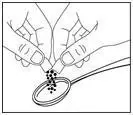
- Open the EMBEDA® capsule and sprinkle the pellets over approximately one tablespoon of applesauce (See Figure 1).
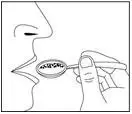
- Swallow all of the applesauce and pellets right away. Do not save any of the applesauce and pellets for another dose (See Figure 2).

- Rinse your mouth to make sure you have swallowed all of the pellets. Do not chew the pellets (See Figure 3).
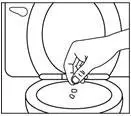
- Flush the empty capsule down the toilet right away (See Figure 4).
- You should not receive EMBEDA® through a nasogastric tube or gastric tube (stomach tube).
This Instructions for Use has been approved by the U.S. Food and Drug Administration.
Manufactured for: Pfizer Inc, New York, NY 10017
by: Actavis Elizabeth LLC, 200 Elmora Avenue, Elizabeth, NJ 07207
LAB-0631-2.0
Revised April 2014
| EMBEDA
morphine sulfate and naltrexone hydrochloride capsule, extended release |
||||||||||||||||||||||||||||||||||
|
||||||||||||||||||||||||||||||||||
|
||||||||||||||||||||||||||||||||||
|
||||||||||||||||||||||||||||||||||
|
||||||||||||||||||||||||||||||||||
|
||||||||||||||||||||||||||||||||||
|
||||||||||||||||||||||||||||||||||
| EMBEDA
morphine sulfate and naltrexone hydrochloride capsule, extended release |
||||||||||||||||||||||||||||||||||||
|
||||||||||||||||||||||||||||||||||||
|
||||||||||||||||||||||||||||||||||||
|
||||||||||||||||||||||||||||||||||||
|
||||||||||||||||||||||||||||||||||||
|
||||||||||||||||||||||||||||||||||||
|
||||||||||||||||||||||||||||||||||||
| EMBEDA
morphine sulfate and naltrexone hydrochloride capsule, extended release |
||||||||||||||||||||||||||||||||||||||
|
||||||||||||||||||||||||||||||||||||||
|
||||||||||||||||||||||||||||||||||||||
|
||||||||||||||||||||||||||||||||||||||
|
||||||||||||||||||||||||||||||||||||||
|
||||||||||||||||||||||||||||||||||||||
|
||||||||||||||||||||||||||||||||||||||
| EMBEDA
morphine sulfate and naltrexone hydrochloride capsule, extended release |
||||||||||||||||||||||||||||||||||||||
|
||||||||||||||||||||||||||||||||||||||
|
||||||||||||||||||||||||||||||||||||||
|
||||||||||||||||||||||||||||||||||||||
|
||||||||||||||||||||||||||||||||||||||
|
||||||||||||||||||||||||||||||||||||||
|
||||||||||||||||||||||||||||||||||||||
| EMBEDA
morphine sulfate and naltrexone hydrochloride capsule, extended release |
||||||||||||||||||||||||||||||||||||||
|
||||||||||||||||||||||||||||||||||||||
|
||||||||||||||||||||||||||||||||||||||
|
||||||||||||||||||||||||||||||||||||||
|
||||||||||||||||||||||||||||||||||||||
|
||||||||||||||||||||||||||||||||||||||
|
||||||||||||||||||||||||||||||||||||||
| EMBEDA
morphine sulfate and naltrexone hydrochloride capsule, extended release |
||||||||||||||||||||||||||||||||||||
|
||||||||||||||||||||||||||||||||||||
|
||||||||||||||||||||||||||||||||||||
|
||||||||||||||||||||||||||||||||||||
|
||||||||||||||||||||||||||||||||||||
|
||||||||||||||||||||||||||||||||||||
|
||||||||||||||||||||||||||||||||||||
| Labeler - Pfizer Laboratories Div Pfizer Inc (134489525) |




